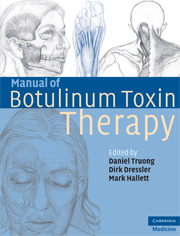Book contents
- Frontmatter
- Contents
- List of contributors
- Foreword – Alan B. Scott
- Preface
- 1 The pretherapeutic history of botulinum toxin
- 2 Botulinum toxin: history of clinical development
- 3 Pharmacology of botulinum toxin drugs
- 4 Immunological properties of botulinum toxins
- 5 Treatment of cervical dystonia
- 6 Treatment of hemifacial spasm
- 7 Treatment of blepharospasm
- 8 Treatment of oromandibular dystonia
- 9 Treatment of focal hand dystonia
- 10 Botulinum toxin applications in ophthalmology
- 11 Botulinum toxin therapy of laryngeal muscle hyperactivity syndromes
- 12 The use of botulinum toxin in otorhinolaryngology
- 13 Spasticity
- 14 The use of botulinum toxin in spastic infantile cerebral palsy
- 15 Hyperhidrosis
- 16 Cosmetic uses of botulinum toxins
- 17 Botulinum toxin in the gastrointestinal tract
- 18 Botulinum toxin in urological disorders
- 19 Use of botulinum toxin in musculoskeletal pain and arthritis
- 20 The use of botulinum toxin in the management of headache disorders
- 21 Treatment of plantar fasciitis with botulinum toxin
- 22 Treatment of stiff-person syndrome with botulinum toxin
- 23 Botulinum toxin in tic disorders and essential hand and head tremor
- 24 Developing the next generation of botulinum toxin drugs
- Index
- References
9 - Treatment of focal hand dystonia
Published online by Cambridge University Press: 28 July 2009
- Frontmatter
- Contents
- List of contributors
- Foreword – Alan B. Scott
- Preface
- 1 The pretherapeutic history of botulinum toxin
- 2 Botulinum toxin: history of clinical development
- 3 Pharmacology of botulinum toxin drugs
- 4 Immunological properties of botulinum toxins
- 5 Treatment of cervical dystonia
- 6 Treatment of hemifacial spasm
- 7 Treatment of blepharospasm
- 8 Treatment of oromandibular dystonia
- 9 Treatment of focal hand dystonia
- 10 Botulinum toxin applications in ophthalmology
- 11 Botulinum toxin therapy of laryngeal muscle hyperactivity syndromes
- 12 The use of botulinum toxin in otorhinolaryngology
- 13 Spasticity
- 14 The use of botulinum toxin in spastic infantile cerebral palsy
- 15 Hyperhidrosis
- 16 Cosmetic uses of botulinum toxins
- 17 Botulinum toxin in the gastrointestinal tract
- 18 Botulinum toxin in urological disorders
- 19 Use of botulinum toxin in musculoskeletal pain and arthritis
- 20 The use of botulinum toxin in the management of headache disorders
- 21 Treatment of plantar fasciitis with botulinum toxin
- 22 Treatment of stiff-person syndrome with botulinum toxin
- 23 Botulinum toxin in tic disorders and essential hand and head tremor
- 24 Developing the next generation of botulinum toxin drugs
- Index
- References
Summary
Definition
Dystonic contractions are often aggravated by purposeful actions and may be specific to a particular task. A patient may have dystonia when using the hand for writing but not for other tasks such as eating or typing. Occupational dystonias are those that occur in individuals with a particular occupation requiring repetitive and excessive fine motor activity. Most of these dystonias are task specific and fall under the rubric of primary focal dystonias. The occupations especially prone to have focal task-specific dystonia are listed inTable 9.1.
In this chapter we discuss in detail writer's cramp and musician's cramp, the two most common occupational dystonias, followed by a brief mention of other focal occupational dystonias.
Pathogenesis
Although the exact cause of these focal dystonias is not yet elucidated, it seems that an interaction of proprioceptive, behavioral, genetic, gestural, environmental, and psychological factors plays a role. Excessive activation of antagonists, overflow into synergists, and prolongation of muscle activation are thought to reflect deficiency of premotor cortical network inhibition (Hallett, 2000, 2006a, b). Decreased levels of the inhibitory neurotransmitter gamma-aminobutyric acid (GABA) are present in the contralateral sensorimotor cortex and lentiform nucleus in patients with writer's cramp (Levy & Hallett, 2002). Functional magnetic resonance imaging shows impaired activation of the primary sensorimotor and supplementary motor cortex during voluntary muscle relaxation and contraction (Oga et al., 2002). A genetic factor in the development of hand dystonia is possible, as up to 20% of patients with writer's cramp have family members with dystonia.
- Type
- Chapter
- Information
- Manual of Botulinum Toxin Therapy , pp. 61 - 76Publisher: Cambridge University PressPrint publication year: 2009
References
- 1
- Cited by

